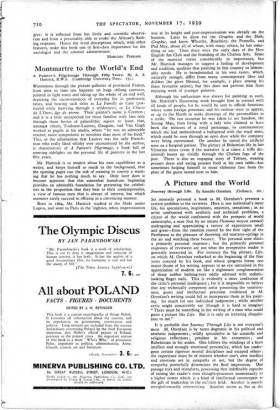Montmartre to the World's End
A Painter's Pilgrimage Through Fifty Years. By A. S. Hartrick, R.W.S. (Cambridge University Press. t5s.)
WANDERING through the picture galleries of provincial France, from time to time one happens on huge oblong canvases, painted in light tones and taking up the whole of an end wall, depicting the inconveniences of everyday life in prehistoric times, and bearing such titles as La Famille de Cain (por- trayed while hurrying through a wilderness), or Le Chasse de L'Ours, age de pierce. Their painter's name is Cormon ; and it is a little unexpected for those familiar with him only through these bevies of palaeolithic supers to learn that, amongst others, Toulouse-Lautrec, Gauguin, and Van Gogh worked as pupils in his studio, where " he was an admirable teacher, more sympathetic to novelties than most of his kind." This, or the information that Lautrec was the only French- man who really liked whisky ever encountered by the author, is characteristic of A Painter's Pilgrimage, a book full of amusing sidelights on the personal life of painters in the last fifty years.
Mr. Hartrick is so modest about his own capabilities as a writer, and keeps himself so much in the background, that the opening pages run the risk of seeming to convey a warn- ing that he has nothing much to say. Only later does it become apparent that this somewhat humdrum beginning provides an admirable foundation for presenting the celebri- ties in the proportion that they bear to their contemporaries, a view of famous men that is always of interest, but which memoirs rarely succeed in offering in a convincing manner.
Born in 1864, Mr. Hartrick studied at the Slade under Legros, and went to Paris in the 'eighties, when impressionism was at its height and post-impressionism was already on the horizon. Later he drew for the Graphic and the Daily Graphic, and knew Whistler, Beardsley, the Pennefls, and Phil May, about all of whom, with many others, he has some- thing to say. Then there were the early days of the New English Art Club and the founding of the Chelsea Arts. Some of the material varies considerably in importance, but Mr. Hartrick manages to suggest a feeling of development and tradition, qualities that painting in this country so lament- ably needs. He is broadminded in his own tastes, which, naturally enough, differ from many contemporary likes and dislikes (he gives Menzel, for example, a place among his three favourite artists); but this does not prevent him from enjoying work of younger painters.
Although his enthusiasm was always for painting as such, Mr. Hartrick's illustrating work brought him in contact with all kinds of people, for he would be sent to official functions where some foreign potentate and his retinue were to appear, or up to the North to make drawings of the personalities in a strike. On one occasion he was taken to see Sandow, the Strong Man, then living with a lady who claimed to have been the mistress of a royal personage, to commemorate which she had embroidered a bedspread with the royal arms, which could be seen through an open door while the company were being entertained. On another he tinted the artificial nose on a hospital patient. The picture of Bohemian life in late Victorian times (even if the narrative is at times a trifle dis- jointed) looms up vividly through the Chelsea fogs of the past. There is also an engaging story of Tolstoy, wearing peasant dress and eating peasant food at his own table—but sometimes helping himself to more elaborate fare from the plate of the guest seated next to him.




































































 Previous page
Previous page